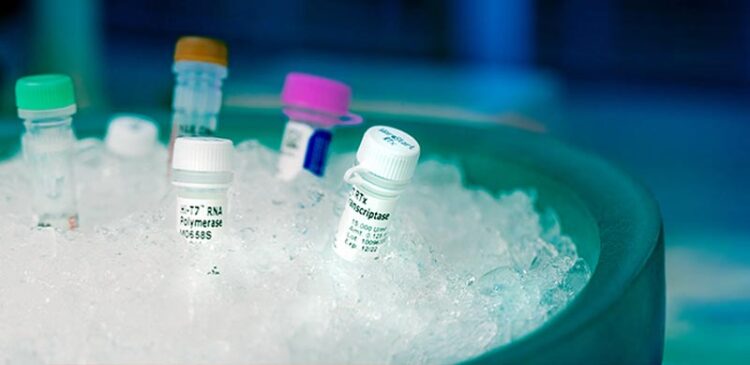Turning up the heat to unlock Cas13’s potential

A CRISPR-Cas system that could be used with RT-LAMP has been developed to specifically detect target genetic material in a one-pot assay without the need for new reagents.
Credit: © 2022 KAUST; Anastasia Serin
A protein from a heat-loving bacterium allows specific detection of SARS-CoV-2 and other viruses in a one-pot assay based on RT-LAMP technology. This test could simplify point-of-care diagnoses of COVID-19 and other infections.
RT-LAMP tests are similar to PCR tests: they detect tiny amounts of viral genetic material in a sample by amplifying it to detectable amounts. One advantage of an RT-test over PCR tests is that it is performed at a single temperature (55-65 degrees Celsius) instead of repeated cycling through different temperatures. This makes it quicker and easier to use. Its disadvantage, however, is that it is not as accurate as PCR as it can produce false positive results.
The test uses RT-LAMP to amplify the number of target virus RNAs in a sample. TccCas13a then recognizes and cuts it, activating it to also cut special fluorescently tagged RNAs that are added to the mix. This produces a fluorescent signal that can be read by a mobile application also developed by the team.
OPTIMA-dx successfully detected SARS-CoV-2 in patient samples. It was also modified to detect other viruses, such as hepatitis C, or even multiple viruses at the same time. The technology has been patented, a prototype produced and clinically validated, and the team is now transitioning the product into a startup phase with the aim of mass production and commercialization.
“Finding the thermostable TccCas13a enzyme is just the start,” says Mahfouz. “We are now investigating other systems to develop biologically inspired disruptive technologies for healthcare, therapeutics and diagnostics.”
Searching through Cas protein databases, they found a promising candidate belonging to a thermophile (heat-loving) bacteria called Herbinix hemicellulosilytica. A further search through protein databases identified another Cas protein with a similar genetic sequence in a thermophile called Thermoclostridium caenicola. Tests showed both Cas proteins were stable at relatively high temperatures, but the TccCas13a protein belonging to T. caenicola remained stable within a higher range (37-70 degrees Celsius).
Following further tests and optimizations, the team was able to use TccCas13a to develop a sensitive, robust and rapid one-pot assay called OPTIMA-dx.
“If an additional specificity factor could be coupled with RT-LAMP to distinguish between true and false amplification, it could help to develop powerful diagnostic technologies,” says KAUST Ph.D. student Ahmed Mahas.
Mahas and a team of scientists working in Magdy Mahfouz’s Lab wanted to find a CRISPR-Cas system that could be used with RT-LAMP to specifically detect target genetic material in a one-pot assay without the need for new reagents. Cas proteins are bacteria’s line of defense against invading pathogens and have been used to detect amplified RNA. However, most RNA-targeting Cas13 proteins function at around 37 degrees Celsius, which is incompatible with RT-LAMP. The team wanted to find a Cas13 enzyme that targets viral RNA and is stable at the temperatures used in RT-LAMP tests.
Journal: Proceedings of the National Academy of Sciences
DOI: 10.1073/pnas.2118260119
Article Title: Characterization of a thermostable Cas13 enzyme for one-pot detection of SARS-CoV-2
Article Publication Date: 28-Jun-2022
All latest news from the category: Life Sciences and Chemistry
Articles and reports from the Life Sciences and chemistry area deal with applied and basic research into modern biology, chemistry and human medicine.
Valuable information can be found on a range of life sciences fields including bacteriology, biochemistry, bionics, bioinformatics, biophysics, biotechnology, genetics, geobotany, human biology, marine biology, microbiology, molecular biology, cellular biology, zoology, bioinorganic chemistry, microchemistry and environmental chemistry.
Newest articles

Trotting robots reveal emergence of animal gait transitions
A four-legged robot trained with machine learning by EPFL researchers has learned to avoid falls by spontaneously switching between walking, trotting, and pronking – a milestone for roboticists as well…

Innovation promises to prevent power pole-top fires
Engineers in Australia have found a new way to make power-pole insulators resistant to fire and electrical sparking, promising to prevent dangerous pole-top fires and reduce blackouts. Pole-top fires pose…

Possible alternative to antibiotics produced by bacteria
Antibacterial substance from staphylococci discovered with new mechanism of action against natural competitors. Many bacteria produce substances to gain an advantage over competitors in their highly competitive natural environment. Researchers…





















